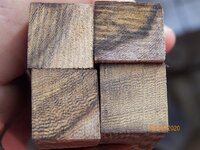Larryreitz
Member
I'm really liking this wood. Pictured below are a Caballero in TiGold hardware and a SPW Longbody with TIGold and Gunmetal. Both are finished with Glu Boost. C&C appreciated as always.
Hi Len,Pheasant wood, that's a new one on me, how is it to work with? Where and how large do they grow to be, are they an ornamental tree? The pens you've made are gorgeous, I love the look of the wood.
Len
 regardless if the wood is a light or dark colour that end-grain layers layout is just stunning, unfortunately, the wood I get has the dimensions of 55x4x2cm but if I had/could get a piece/board 130mm wide and at least 21mm thick I would be cutting lots of cross-cut blanks and stabilise them for further strengthening, I may make a glue-up I doubt we would be able to see the joints, I will try and report.
regardless if the wood is a light or dark colour that end-grain layers layout is just stunning, unfortunately, the wood I get has the dimensions of 55x4x2cm but if I had/could get a piece/board 130mm wide and at least 21mm thick I would be cutting lots of cross-cut blanks and stabilise them for further strengthening, I may make a glue-up I doubt we would be able to see the joints, I will try and report.New to pen turning and was wanting to know about wood stabilization. What is the best method. I only bring this up since you mentioned it.
There is a lot that can be said about wood stabilisation, there 2 main types used, the industrial and the DIY that we are doing using the Cactus Juice. The Industrial wood stabilisation uses enormous tanks/vessels and pressures up to 5,000 PSI, the DIY method is made using small vacuum chambers where the wood is inserted into and filled with the CJ, there is a vacuum pump that removes all air from the chamber and wood allowing the CJ to penetrate after that the wood is cooked in the oven to cure/harden the CJ. In general terms, wood stabilisations give the wood liquid penetration protection, hardens the wood and gives the wood a semi plasticised properties without changing its appearance.New to pen turning and was wanting to know about wood stabilization. What is the best method. I only bring this up since you mentioned it.
